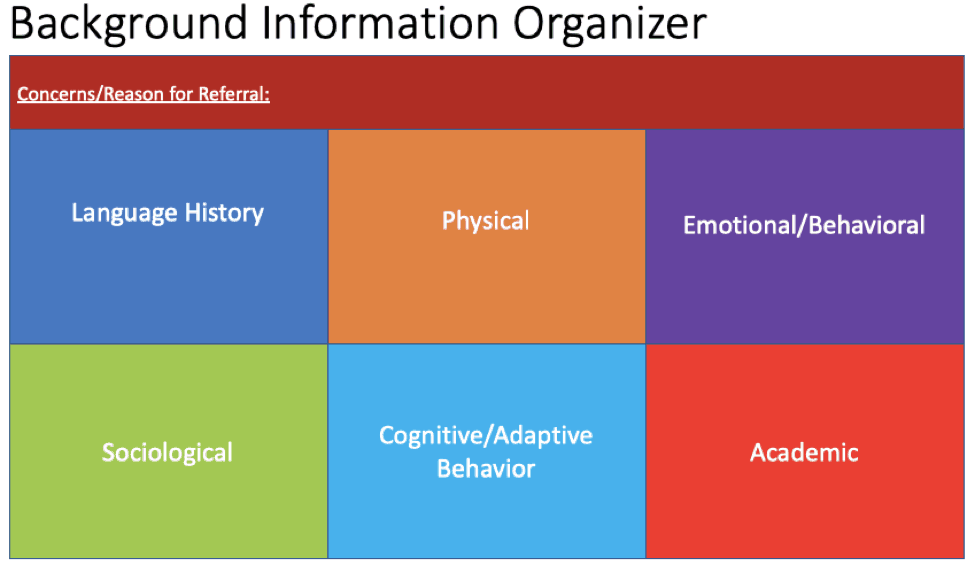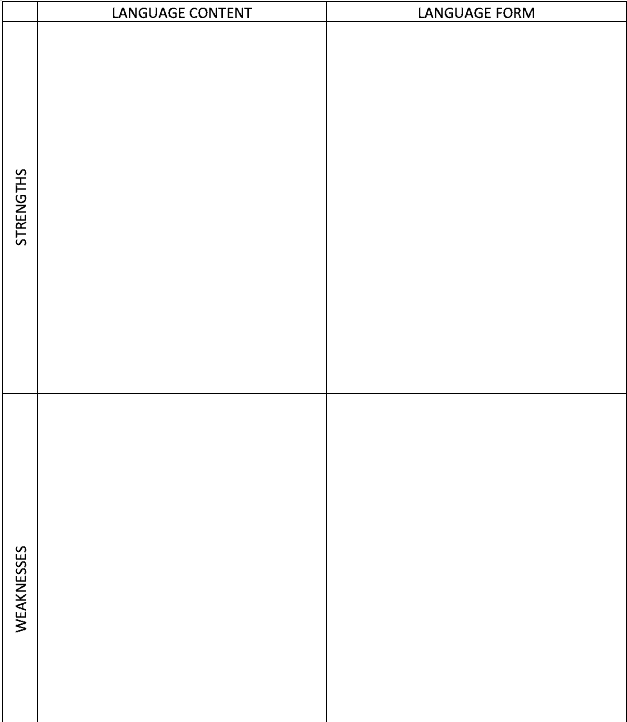There are certain testing situations where we cannot use the scores from the beautiful tests that have been made for us and it can be super frustrating. In these cases, there isn’t a test that matches our needs. For example, the child doesn’t speak English or the child has other disabilities that do not allow for a standardized administration of the test. And at the same time, using standardized scores is in our SLP-DNA so it just feels wrong. On top of that, our clinic directors and insurance companies may kick an evaluation back that does not have numbers. Or, our school district has a list of needed report components and standardized testing is italicized, bolded, and underlined on that list, just to make sure we don’t miss it.
Standardized scores for speech language evaluations are a portion of testing results that help inform diagnostic decisions and insurance decisions about covering treatment. When qualifying for services requires standardized scores but there is no valid test for a particular client, it can make testing, qualifying, and funding decisions difficult.
What we need is help identifying when the use of standardized testing isn’t appropriate, a way to still get the results we need, and a way to let everyone above us know it’s okay. That’s what we are going to walk through here. Afterwards, we wrote two additional essays which are case studies for non-standardized-testing for articulation and non-standardized-testing for language so you can see an example of how it’s done.

What if We Had No Standardized Tests?
I want you to take a walk with me through an alternative universe: Pretend that there is no such thing as a standardized score, or even a test, for that matter. How would you do an assessment? What would you do in your session? Does this sound scary to you or do you feel a sense of relief living over there? For me it’s a bit of both but here is what it would look like:
For speech, you would talk or say words and record it somehow. For every 100 words you would note how many you understand or you would ask a parent or interpreter to do the same (% intelligibility). If something was said incorrectly, you would make a list that looks like; “he said D and it should have been G.”
Fluency would look much the same. You would count dysfluencies per 100 words and write down what kind of repetitions or differences you saw. If they crossed a threshold (3%) you would address them.
For language, you would have them tell a story. You would judge the story based on size, grammar, and what the story contains. Putting that back in our SLP nerd language, you are looking at MLU, syntax complexity, and narrative development.
For each situation, you could use a “preordained list” (a.k.a standardized test section) of things the child should do. In the report you would just describe it, not use any numbers. Let’s say there are concerns about following directions and you have handy-dandy lists called Sentence Comprehension (SC) and Following Directions (FD) (Thank you CELF-5). Your write-up would say something like:
“Mohammad was asked to point at objects that varied by size, shape, and number. The instructions began with easy tasks (point to the triangle) and increased in complexity (point to the blue triangle that is second from the end). He correctly followed 14/17 instructions. Of the three he missed, two included the phrase “do X before you do Y.” The third item had four steps he had to correctly perform in order.
We did a teaching session on the words before and after and he followed 7/8 before/after instructions correctly after the teaching session.”
Basically, you would do your SLP job just as well as you always do. By the end, you would feel good about the decision you made and confident in the goals you chose. The only thing you would be missing is a way to explain in your report WHY you didn’t do it the standardized way.
Here’s the trick I just pulled on you. This is our universe. This is our life for every kid who does not match the norming sample. This is every student who speaks a language other than English (or English and Spanish). This is possibly your students who come from a different culture. This could even be your students who have another eligibility like ADHD or a learning disability.

What Does Non-Standardized Testing Look Like?
Let’s walk through this. The process for non-standardized and standardized testing looks pretty similar in the beginning but we need to be aware of some specific information and know when to abandon the formal testing ship.
Planning for the Evaluation
So we get our referral packet, which is a pile of information. Yes, literally a pile of information. And when it is a bilingual child or a child with another disability it can be really quite overwhelming at times. We get work samples in two languages. We get the language proficiency information. For children already in special education, we get their work samples and information from both the general education and special education teacher… It’s a lot. We recommend that you utilize this background information organizer that you can download here because it really helps you to get everything into the right place so that you can easily look at all of that information and make decisions about your plan for your evaluation. It also helps in facilitating your writing process.

One of the things that we have in our bilingual evaluation packets that does not exist in monolingual evaluation packets is all of the language proficiency information. This can be the home language survey, ESL paperwork, or bilingual classroom placement decisions. More often than not, a conversation with the parent is THE BEST current explanation of their language exposure and use. The school proficiency paperwork is often filled out in Pre-K and a lot of language development has happened since then. Why is this important? You need this to figure out what testing to do and whether you need help from a native speaker.
We know from current research that when we have kids whose language exposure is less than 20% in a given language, standardized tests in that language do not inform our diagnostic decisions much at all. So maybe we shouldn’t waste our time administering a standardized test to a student who has a current exposure below 20%.
We know that test creators have described the makeup of the normative sample. They say that testing someone who does not match the normative sample may not yield accurate results. Basically, they are telling us not to report scores if the scores were not developed with kids like the one we are testing.
Children who qualify for other special educational services are often not in the normative sample. Think of it this way, their other goals such as reading or writing, are the ways you have to alter your testing to try to get to their communication. For example, if a child has an attention deficit, we may have to break tasks into smaller pieces and/or repeat them a couple of times, which is not the way we are supposed to administer the test. When that’s the case, we don’t use the norms.
Note that we are suggesting that we ditch “standardized scores” not “standardized testing.” Go ahead and give the standardized measures but write it up with an explanation, not numbers. Here is an example:
John was administered the Recalling Sentences portion of the CELF-5 where he was asked to repeat sentences. Out of the 11 sentences he was asked to repeat, he successfully repeated 3 which were up to 4-words long. An information testing session was undertaken using 6-word utterances. John successfully repeated 0/7 6-word sentences. When the sentences were broken in half and he repeated 3-word segments, he was successful in 7/7 trials.
Organizing the Information
We make our decisions about what tools we’re going to use and whether we’re going to use standardized testing based on our proficiency information that we get and our discussions with parents and teachers. After we administer our standardized and our non-standardized assessments, we need to organize that information so we can write it up.
For this we created the evaluation writing organizer for receptive and expressive language. It really breaks down how we want to think about all of the information. It also makes it really easy to pull both information from the standardized and the non-standardized assessment and get that all in one nice, neat place.

Choosing Goals when Non-Standardized Testing is Needed
For bilingual children, we do not want to write goals and recommendations around home language influence patterns. Those don’t belong in our speech and language goals. We want to focus on the things that we see they’re struggling in both languages. Lots to say on that but check out our foundational speech and language courses if you want to know more.
For our children with other disabilities, we don’t want to write goals that they would be struggling with because of their disability. We want to focus solely on the communication aspect. Most importantly for this group, we don’t want to overlap with something that the special education teacher is already focusing on due to their primary disability. That’s “duplication of services.”
Writing it Up.
You need to say one of two things when writing a report where standardized scores could not be used:
- Standardized testing was not used + the reason. Usually you need to include the reason that the child is not in the normative sample.
- Standardized testing was used but scores were not reported + the reason. Again, include the reason that the child is not in the normative sample. Then say: Standardized testing was conducted in English, however, as the student is not represented in the normative sample, standardized scores are not valid and not reported here. Qualitative information from the administration of the English test is included below in a discussion of STUDENT’s strengths and weaknesses.
Non-Standardized Testing Report Text Example:
The speech and language assessment was completed in both English and Spanish by a bilingual speech-language pathologist. Standard evaluation procedures were used during standardized testing.
OR
Parent/Other served as interpreter for the evaluation and therefore standard evaluation procedures were not used.
A note regarding the bilingual assessment framework: Speech and language testing is designed to differentiate children who have speech and language disorders from those who are typically developing, rather than for the purpose of determining language proficiency. Language proficiency tests are typically administered by general educators to determine classroom placement. The primary reason for a speech and language referral is to rule-out an underlying disorder in communication abilities. When a child is exposed to two languages, this is investigated using a “difference vs. disorder” approach. Specifically, assessment data is obtained in both languages of exposure. Any noted errors or differences in communication skills are then analyzed and assigned to three main categories: 1) errors appropriate for the child’s age (developmental errors); 2) errors attributed to the interaction between the two languages spoken (cross-linguistic influence); and 3) atypical errors. Evaluation results take into consideration skills in both languages to indicate a child’s overall communication abilities.
Standardized testing was conducted in English based on a history of exposure to English and HOME LANGUAGE skills were probed informally.
OR
Based on the findings of informal probes in English and parental report that STUDENT is only exposed to and only uses HOME LANGUAGE, formal English testing was not indicated for the purposes of assessing underlying language skills.
OR
Standardized testing was conducted in English, however, as the student is not represented in the normative sample, standardized scores are not valid and not reported here. Qualitative information from the administration of the English test is included below in a discussion of STUDENT’s strengths and weaknesses.
And that’s it. Use your standardized tests to give you good qualitative information and ditch the standardized scores. Your report will contain information that is useful for understanding the student’s skills and for moving forward with goal planning if needed.


 Share
Share
 Tweet
Tweet
 LinkedIn
LinkedIn
 Pin
Pin
 Email
Email

